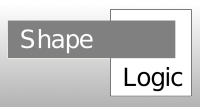
Until ShapeLogic's 1.0 release, the image processing algorithms where only running under ImageJ .
Now ShapeLogic's image processing algorithms have been decoupled from ImageJ. The idea is not to redo ImageJ's functionality but to make ShapeLogic more modular. All of ShapeLogic's current image processing algorithms only use very simple image properties so they should apply outside of ImageJ.
Not everything will work outside of ImageJ. The letter match example has a first step that is a skeletonize algorithm that comes with ImageJ. I you want to use the full letter match example outside ImageJ you will need another implementation of the skeletonize algorithm.
Main idea was to abstract out a subset of the ImageProsessor and PlugInFilter into Java interfaces:
It is trivial implement them them in ImageJ and simple to do it in Java2D. When writing a image processing algorithm write an ImageOperation instead of a PlugInFilter.
This is a wrapper interface that contains very simple properties of an image.
In order to get a new image format to work transparently with ShapeLogic you need to make an adaptor pattern that for you image class to this interface.
This is a wrapper around a PlugInFilter. It is any operations that can change a SLImage.
PlugInFilterAdapter is the way to turn an ImageOperation into a PlugInFilter that can be run from ImageJ. Here is an example:
StreamVectorizer is an ImageOperation for vectorizing bitmaps and finding letters it it. It can be called with any SLImage, while StreamVectorizer_ is the letter matching example that you can use in ImageJ.
public class StreamVectorizer_ extends PlugInFilterAdapter {
public StreamVectorizer_() {
super(new StreamVectorizer());
}
}
Here are some of the main Java image libraries order by complexity of the image classes.
ImageJ only have 4 different images.
Implemented by 4 subclasses of the ImageProcessor:
The focus is simplicity for the programmer. There is only one image layout for a given image type.
Java2D's main image format is BufferedImage. This is a very flexible class that can handle most non compressed layouts of a image that is loaded in a buffer.
JAI is a pretty complex image processing and rendering library. It can be used to handle big flow of operations and images that are too large to be loaded in memory at the same time.
ImageJ is a fantastic tool for image processing. Here are a few of its features: